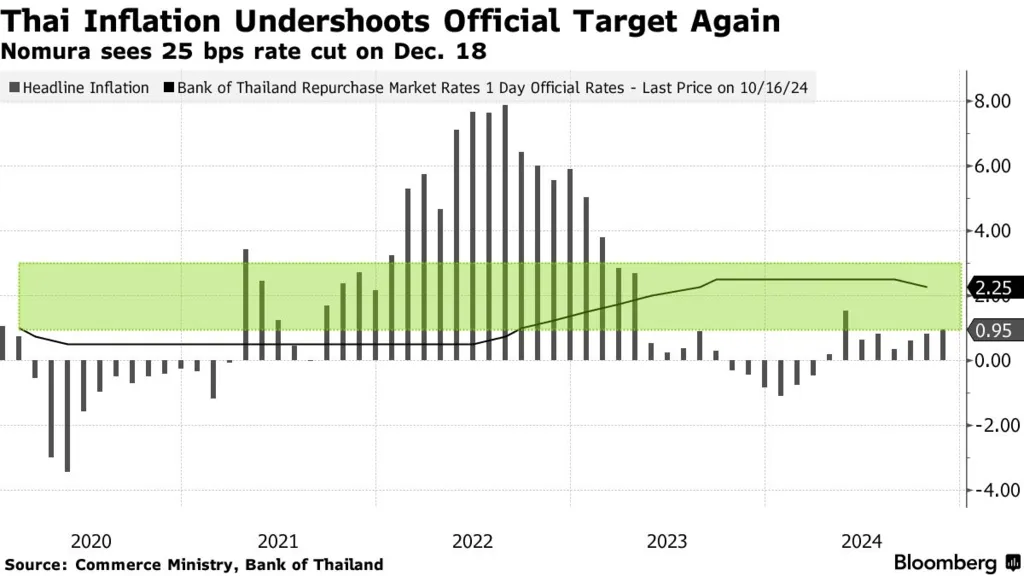Thailand is experiencing a rare economic trend: three straight months of negative inflation. In June 2025, the country’s consumer prices fell by 0.25% year-on-year. This deflation streak, which started in April at –0.22% and deepened to –0.57% in May, has pushed inflation outside the central bank's target range of 1%–3%. As a result, Thailand Inflation & Policy Flexibility has become a central theme in the country’s economic discussions.
Headline vs Core Inflation: A Complex Picture of Thailand Inflation & Policy Flexibility

While headline inflation turned negative, core inflation tells a different story. And this already excludes volatile food and energy prices. In June 2025, core inflation rose to 1.06% year-on-year. This rebound suggests that underlying price pressures remain despite the headline deflation.
In the first five months of 2025, Thailand’s average annual inflation rate was just 0.48%. Recognizing these trends, the government has revised its full-year inflation forecast down to a range of 0.0%–1.0%. These figures show the unique balance Thailand is navigating: managing subdued overall price growth while addressing specific sectors where costs continue to rise.
Central Bank Emphasizes Policy Flexibility
The Bank of Thailand has made it clear that Thailand Inflation & Policy Flexibility go hand in hand. In April 2025, the central bank cut its key interest rate to 1.75%, the lowest in two years. Officials emphasized their willingness to ease monetary policy further if needed to support economic growth.
Previously, when the policy rate was maintained at 2.50%, it was described as “policy optionality.” This approach allowed the central bank to react quickly to changing conditions, including currency fluctuations and unexpected economic risks. By focusing on flexibility, the central bank is preparing for an era where inflation targets may be harder to meet consistently due to global shocks and structural shifts.
Thailand Inflation & Policy Flexibility: A Proactive Approach to Global Uncertainty
Deputy Governor Piti Disyatat reinforced this adaptive stance, stating that the central bank is prepared to adjust its policy again if required. His comments highlight the importance of Thailand Inflation & Policy Flexibility in navigating a challenging global environment marked by supply chain disruptions, energy price swings, and geopolitical tensions.
The central bank’s headline inflation forecast of 0.0%–1.0% for 2025 indicates cautious optimism. While deflation raises concerns about weak demand and potential economic slowdown, the positive core inflation suggests resilience in domestic consumption and services.
Read Also: Thailand Tariff Avoidance Strategy: A Risky Gamble to Win Over US?
Implications for Growth and Stability
The interplay between negative inflation and monetary policy flexibility has significant implications for Thailand’s economic growth. On one hand, lower prices can help support household spending in the short term. On the other, persistent deflation could deter investment and slow wage growth, posing longer-term risks.
By emphasizing this strategy, the central bank aims to keep the economy stable while creating space for growth. The recent rate cut and readiness to adjust further demonstrate a proactive rather than reactive approach.
Read Also: Thailand GDP Growth Forecast Faces Harsh Reality
Thailand Inflation & Policy Flexibility: Ahead
Thailand’s ongoing deflation trend and the central bank’s flexible policy response illustrate a delicate balancing act. With core inflation showing signs of strength and policymakers ready to intervene, Thailand is working to maintain growth momentum despite global uncertainties.
Ultimately, the focus on Thailand Inflation & Policy Flexibility reflects a strategy designed to ensure economic resilience and prepare for future challenges. As the country navigates this complex landscape, its commitment to both stability and growth remains clear.







